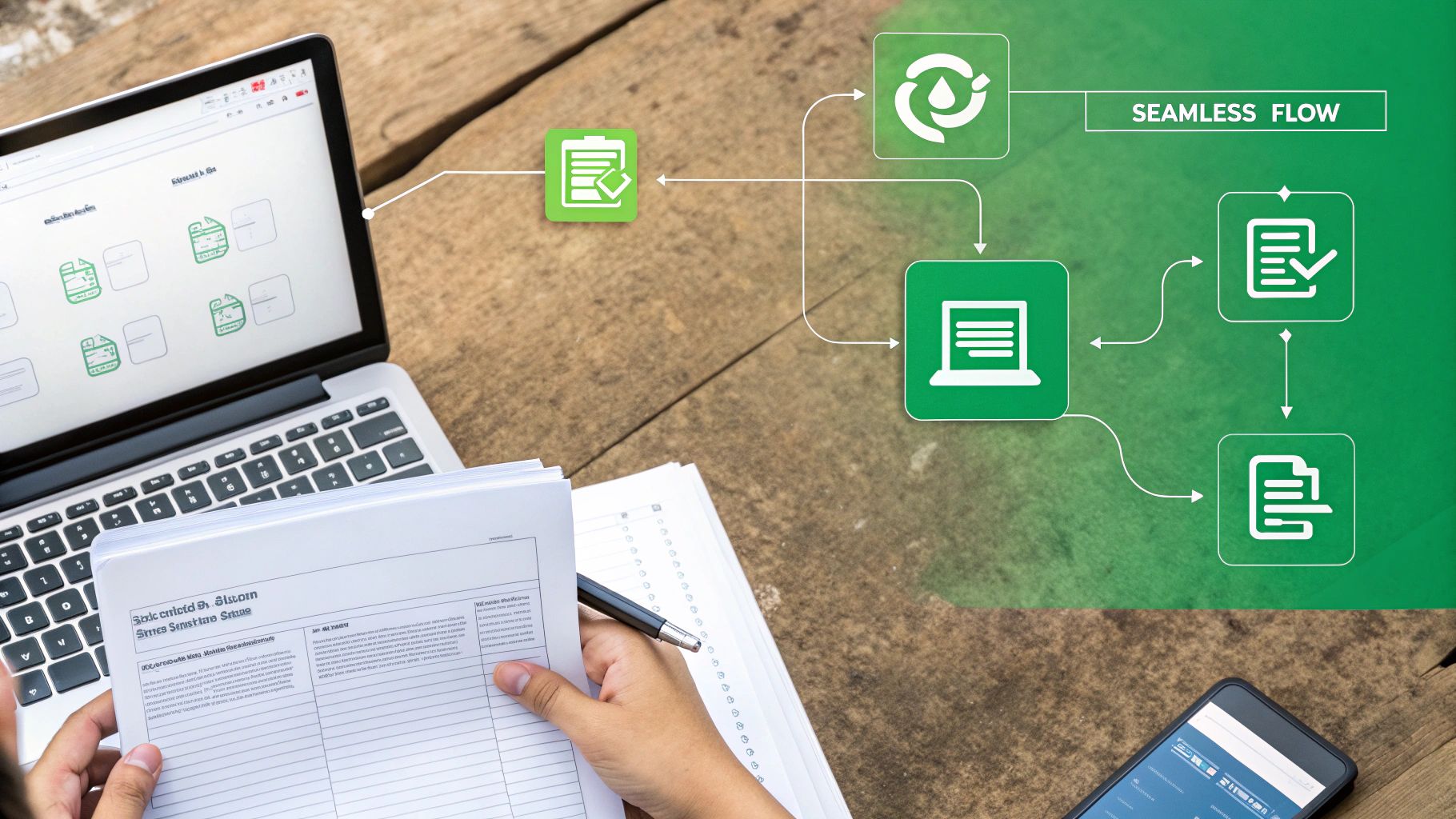Transform operations with automated document generation to cut costs, boost productivity, and enable sustainable growth. Learn more!

The journey of automated document generation has been truly impressive. We’ve moved from painstaking manual processes to intelligent systems capable of producing complex documents with minimal human input. Early automation efforts tackled simple tasks like mail merges. These offered limited flexibility and still demanded considerable manual work. It was a first step, but the real potential remained unrealized.
The need for greater efficiency drove continued innovation, leading to more sophisticated solutions.
This mirrors the overall advancement of document processing technologies. The latter half of the 20th century, for instance, saw the digitization of documents revolutionize how we store and retrieve information. The arrival of Optical Character Recognition (OCR) enabled computers to “read” printed text. This dramatically reduced manual data entry and improved document analysis. This shift laid the foundation for powerful tools like Intelligent Document Processing (IDP).
IDP leverages AI and machine learning to automate data extraction from unstructured documents like contracts and invoices, further streamlining document workflows. This allows businesses to process information faster and more accurately. Learn more about the history of intelligent document processing here.
Early automated document generation relied heavily on templates. These pre-formatted documents provided a basic structure for creating standardized content. However, they lacked the flexibility to handle variations or complex data. This limitation spurred the development of more dynamic methods. The emergence of API-driven document generation was a significant leap forward. This allowed different software systems to communicate and exchange data seamlessly. This opened up exciting new possibilities for integrating document creation with other business processes.
Today, automated document generation is powered by artificial intelligence. AI algorithms allow systems to learn from existing documents, recognize patterns, and generate highly customized content. This means repetitive tasks can be fully automated, freeing human employees for more strategic work. This has fueled the creation of tools like DocuWriter.ai, specifically designed to automate code and API documentation, a vital part of modern software development. This ensures better accuracy and consistency in documentation, crucial for code quality and team collaboration.
Automated document generation is constantly evolving. New AI and machine learning advancements promise even higher levels of automation and personalization. As these technologies mature, businesses can anticipate continued improvement in efficiency, accuracy, and overall document quality. The future lies in seamless integration with other business systems. This will create a unified and efficient approach to information management. Organizations will not only generate documents efficiently but also extract valuable data from them for better insights and informed decision-making.

Automated document generation is more than just a way to create documents faster. It represents a significant shift in how businesses operate, offering substantial financial and operational advantages. It impacts key areas such as efficiency, regulatory compliance, and the overall customer experience.
Automating document generation streamlines previously manual processes. This frees up valuable time, allowing employees to focus on more strategic tasks. This increased efficiency translates directly into cost savings. Furthermore, minimizing manual data entry reduces errors, leading to greater accuracy and less rework, creating a more efficient and cost-effective workflow.
The impact of automated document generation is significant. Implementing Intelligent Document Processing (IDP), for example, can reduce processing time by 50% or more, boosting productivity. In the financial services sector, IDP has saved companies approximately ****860 million in 2021 to over $4.15 billion by 2026, a 37% compound annual growth rate. These figures highlight the potential of document automation in modern business. More detailed statistics can be found here.
Staying compliant with regulations and internal policies can be challenging. Automated document generation simplifies this process by ensuring consistency and accuracy, reducing the risk of errors that could lead to costly penalties. This strengthens operational integrity and improves overall risk management. For more information on documentation best practices, see Best Software Documentation Examples for Development Teams.
Providing excellent customer experiences is essential in today’s competitive landscape. Automated document generation enables businesses to create personalized and timely documents, leading to higher customer satisfaction, stronger relationships, and increased loyalty. This improved communication fosters trust and enhances brand perception.
Tracking the right metrics is crucial for understanding the ROI of automated document generation.
By monitoring these metrics, businesses can gauge the effectiveness of their automation efforts and identify areas for improvement, enabling continuous optimization of document processes.
To further illustrate the impact of document automation, consider the following table:
The table below summarizes the business impact of automated document generation, comparing key metrics before and after implementation.
Business Impact of Automated Document Generation
This table highlights the substantial improvements achieved across various business metrics after implementing document automation. The reduction in turnaround time, error rate, and cost per document, coupled with the increase in customer satisfaction, demonstrates the significant positive impact of this technology. These improvements contribute to a stronger bottom line and a more competitive market position.

The world of automated document generation is constantly evolving, thanks to rapid advancements in artificial intelligence and machine learning. These advancements promise to fundamentally change how businesses handle documents – from creation and management to how they use them strategically. Keeping up with these trends is essential for any organization looking to stay ahead of the curve and optimize its operations.
Generative AI is set to transform template creation. Forget static templates; with generative AI, businesses can create documents dynamically based on specific data. This leads to more personalized documents, generated faster and more efficiently. Imagine crafting a sales proposal perfectly tailored to each client’s needs – that’s the power of generative AI.
Natural Language Processing (NLP) is another significant development in automated document generation. NLP algorithms can understand the meaning and context of text, creating human-quality content from structured data. This opens up a world of possibilities, from generating complex legal documents to producing highly targeted marketing materials. Document automation plays a vital role in efficient content processes. Learn more about effective content creation in this insightful article on content marketing for startups.
Integrating seamlessly with other business systems is becoming crucial. Automated document generation tools must connect with CRM platforms, databases, and other applications to deliver maximum value. This integrated approach streamlines workflows and ensures data consistency across the organization.
Several market trends are driving the evolution of automated document generation. The rise of remote work demands efficient digital document workflows. Increasing regulations require greater accuracy and compliance in document creation. And customers now expect personalized, engaging document experiences. The document automation software market is booming, expected to hit $24.338 billion by 2032, with a CAGR of 15.18%. This impressive growth is driven by factors like digital transformation efforts and the increasing integration of AI and machine learning. You can find more detailed statistics here.
The following table provides a regional breakdown of this growth:
Document Automation Market Growth by Region
Note: Replace X, Y, and Z with actual data from the provided source link.
This table highlights the substantial growth expected across all regions, with specific regional variations based on factors like current adoption rates and projected digital transformation investments.
Looking ahead, certain capabilities will set industry leaders apart. These include advanced analytics to track document performance, robust security features to protect sensitive information, and flexible deployment options to accommodate different business needs. By adopting these capabilities, organizations can future-proof their document processes and fully realize the power of automated document generation.

Choosing the right document automation solution can be tricky. Some offer basic tools, while others provide advanced features that can significantly impact your workflow. Understanding these key differences is vital for selecting the perfect fit for your business needs.
A vast library of templates might seem impressive, but the real advantage lies in template intelligence. This means more than just pre-filled forms and basic formatting. Intelligent templates adapt to your data, ensuring accuracy and consistency.
For example, an intelligent template could automatically adjust contract clauses based on the specific client or project. This dynamic adaptability sets elite document automation apart.
Effective document automation depends on smooth data integration. Connecting to various sources – like CRMs, databases, and other business applications – is crucial. This removes manual data entry, saving you time and reducing errors. Real-time data integration also ensures your documents are always up-to-date.
Artificial intelligence (AI) is becoming increasingly important in document automation. However, not all AI features are equally useful. Focus on features that provide tangible benefits, such as automatically generating content from your data.
For instance, AI can summarize key findings from a large dataset and include them in a report, boosting efficiency and document quality.
Security is essential for any document automation solution. Strong security measures, such as encryption and access controls, safeguard sensitive data and help maintain compliance with industry regulations. This is particularly important for sectors dealing with confidential information, like finance and healthcare.
A user-friendly interface is key for successful implementation. A complicated system can hinder adoption and limit the tool’s effectiveness. Look for solutions with intuitive interfaces that require minimal training, allowing everyone to quickly create and manage documents.
Top-tier document automation platforms integrate smoothly with other business tools. This streamlines workflows, connecting document generation with processes like contract management and e-signatures. This turns document automation from a standalone tool into a central part of your operational efficiency. DocuWriter.ai, for example, focuses on automating code and API documentation, a critical aspect of modern software development.
Implementing automated document generation successfully involves more than just picking the right software. It requires a strategic approach, careful planning, and a solid understanding of your organization’s specific needs. This blueprint guides you through the key implementation phases, from initial assessment to continuous optimization.
Before choosing any software, examine your existing document processes. Identify bottlenecks, inefficiencies, and pain points. Where are you losing the most time? Where do errors frequently occur? What frustrates your team the most? This honest evaluation establishes a baseline for measuring the impact of automation and defines your specific requirements. For example, if your team spends hours manually filling out contracts, prioritize solutions with strong template automation and data integration capabilities.
Set clear, measurable goals for your document automation implementation. While efficiency gains are important, consider other key metrics. How will automation affect accuracy, compliance, and customer satisfaction? These broader metrics provide a more complete view of automation’s value. Quantifiable goals also justify the investment and demonstrate the project’s ROI. You might be interested in: How to master documentation in agile development.
Choosing the right software is crucial. Look for solutions that fit your workflows, not the other way around. Consider factors like template intelligence, data integration capabilities, security features, and usability. A user-friendly interface is essential for successful adoption. A complex system will frustrate users and limit the tool’s effectiveness. Ensure the solution offers the customization and flexibility you need to meet your specific document requirements.
Transitioning from older systems requires careful planning and communication. Involve stakeholders across the organization to ensure a smooth transition. Address any concerns and emphasize the benefits of automation for each team. This fosters buy-in and minimizes resistance to change. Providing adequate training and support for your team is vital for successful adoption.
Resistance to new technology is expected. Address concerns directly, clearly explain the benefits, and involve users in the implementation process. This collaborative approach builds confidence and eases the transition. Showcasing early successes can motivate hesitant team members and demonstrate the value of automated document generation.
Develop a realistic implementation timeline based on your organization’s size and complexity. Allocate sufficient resources, including budget, personnel, and training materials. This ensures a smooth and efficient rollout. Break the project into smaller, manageable phases to track progress and adapt as needed. For example, start by automating a specific document type or department before scaling across the whole organization. Regularly evaluate progress and adjust based on user feedback and performance data. This iterative approach maximizes success and allows you to fine-tune the implementation to meet your specific needs.
Implementation is not a one-time event. Continuously monitor the system’s performance, gather user feedback, and identify areas for improvement. This ongoing optimization ensures your automated document generation process remains efficient, effective, and aligned with your changing business needs. As your organization grows and evolves, your document automation solution should adapt accordingly.
Automated document generation is changing how industries that handle lots of documents operate. From legal and healthcare to finance and real estate, businesses are discovering ways to boost efficiency, accuracy, and customer satisfaction. Let’s look at some real-world examples of this technology’s impact.
Law firms often deal with massive amounts of paperwork. Automated document generation significantly cuts down the time spent creating contracts. One firm, for instance, reduced its contract generation time by 85% after implementing this type of system. This not only saved time but also improved compliance by ensuring all contracts met the required legal standards. This also allowed lawyers to focus on more strategic tasks, such as client consultations and case strategy.
Healthcare providers are under pressure to maintain accurate and current patient records. Automated document generation streamlines this process. One hospital significantly reduced documentation time, allowing medical staff to spend more time with patients. This led to better patient care and improved staff satisfaction. Automated systems also minimized errors in patient data, enhancing overall care quality.
Financial institutions process large volumes of documents every day. Automating loan processing is one key area where document generation offers major advantages. One bank significantly accelerated loan approvals by automating document creation and verification. This faster processing improved customer satisfaction and lowered operational costs. The automated system also minimized errors and ensured regulatory compliance, reducing the institution’s risk.
Insurance companies use automated document generation to create personalized policy documents and streamline claims processing. This personalized approach enhances the customer experience with clear, easy-to-understand documents. One insurance company, for example, automated its claims process, resulting in quicker payouts and greater customer satisfaction. This more efficient process also reduced the administrative workload on staff.
The real estate industry depends on accurate and prompt documentation. Automated document generation helps real estate agents manage contracts, leases, and closing documents more efficiently. This speeds up transactions and improves accuracy, benefiting both buyers and sellers. By automating these processes, real estate professionals can concentrate on building client relationships and closing deals.
These examples show how versatile automated document generation is across various industries. By automating tedious and repetitive tasks, these organizations have not only improved efficiency and reduced costs but also enhanced the customer experience. As technology continues to develop, we can anticipate even more advantages from this powerful tool.
Ready to experience the power of automated document generation? Explore DocuWriter.ai’s solutions for automating your code and API documentation.